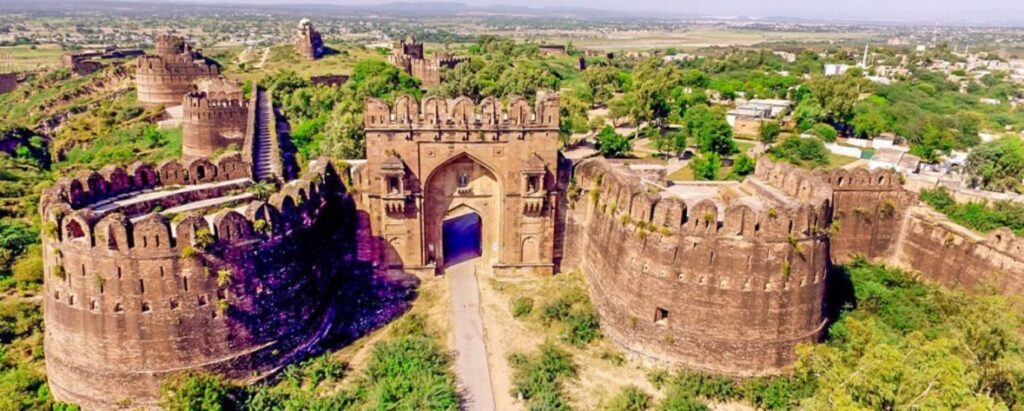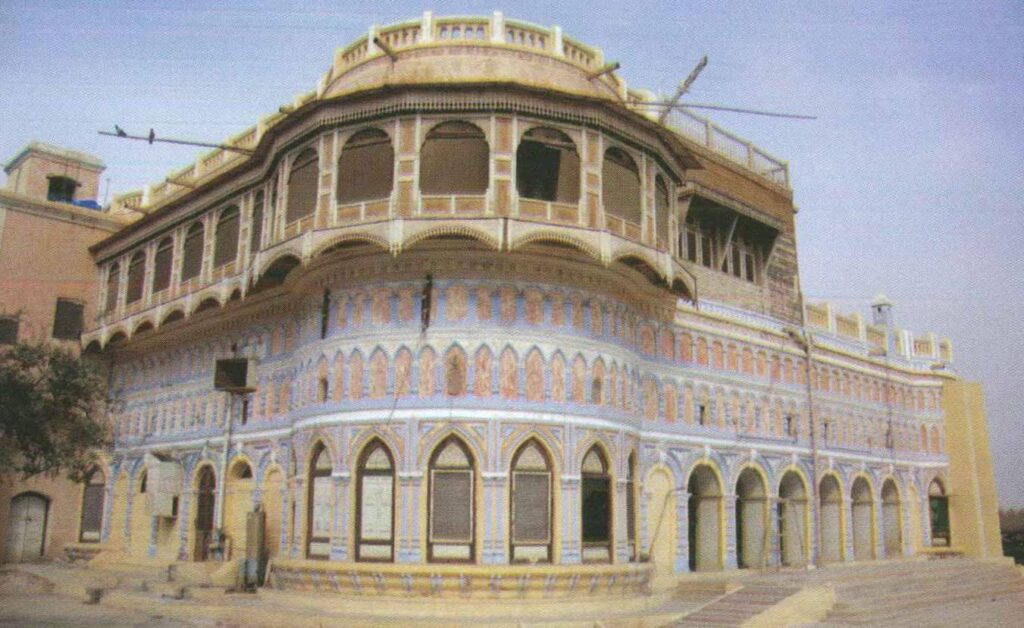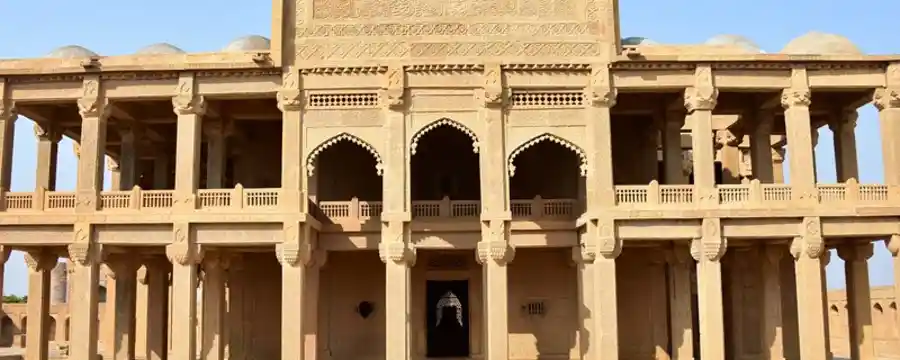
Introduction
Pakistan is a country that describes its history and cultural heritage. Frame describes various cultures of people who surround it. The most prominent characteristic features of this frame are those of Forts that describe the history of earlier rulers, military strategic location, and architecture over hundreds of years. This list narrates some of the important castles in Pakistan, their historical importance, architectural features, and their cultural history.
1. Rohtas Fort
Rohtas Fort is one of the heritage places of the world close to Jhelum in Punjab and has been tagged as a masterpiece of military architecture. This was constructed by Afghan ruler Shershah Suri in the 16th century for the Mughal emperor, Humayun not to regain India this fortification was constructed above river Jhelum at the top of the hill making this among the riskiest fortifications in the department of the army.

The fort has high walls with the highest bastions and great gateways. Amongst these, the “Shahi Darwaza” happens to be one of the greatest entrances which have got such decorated carvings over it. It covers an enormous area, with all kinds of buildings- Mosques, Water Reservoirs, accommodations, etc.
Cultural Significance
One wears the history of resistance and perseverance as the sole symbol of the historic struggle that hails from this soil, so it stands as one of the favorite destinations for each history enthusiast or architecture admirer. The other structure has also acquired an international status based on its historical background like the Bahawalpur Fort.
2. Bahawalpur Fort
Bahawalpur Forts dates back to the 18th century. Bahawalpur Fort does exist in the Bahawalpur city. It was planned and constructed by the Nawabs of Bahawalpur. The seat of Nawabs along with his court was seated just behind the doors of Bahawalpur Fort. It had an edifice wherein the administration went very relatively easy and he could save it to extreme ends from the danger lurking through outer channels.

Architecture
It is such a picturesque mix of the two styles, that come from two archaic style completely different styles. They pretty much seem aesthetically convincing in red bricks, fine tile work, and vast courts. This beautiful garden had its name in a very beautifully beautiful palace of Noor Mahal.
Conservation
Bahawalpur Forts has recently been taken up for restoration work and is recommended as a cultural heritage site. Diversified restorative plans are being initiated to begin the process wherein the framework and skeletal part of the construction shall be preserved but the viewing experience shall be enriched on myriad dimensions.
3. Khanpur Fort
Brief History:
This local is a locality called Khanpur and was once famous for being the residence place of Sikh and Mughal histories. The locality of this fort is reported to be a military fort-one which’s grounds were used at times as a locale for holding military operations.

This particular construction has very noticeably highly dense walls with only two watch towers erected looking out to all sides given the surrounding landscape. This type of architectural design of the buildings for this monument, thus, evolved with time and through more involvement by the Mughals mixed with flavors of Sikh can be noticed in the country of India.
Contemporary Relevance
Now, very few tourists pass by to glance over the Khanpur Forts. In comparison to the tourist visiting crowd that other forts of this region attract, well that too is another monument from the ancient. Even here could be still an after-echo of war strategy in this battle-fielded land of Mughal and Sikh kings.
4. Takkar Fort
History
Takkar Forts is situated in the northern province of Pakistan, Khyber Pakhtunkhwa. It is one of the structures during the Mughal period and earlier it was the fortification of the local ruler. The structure was made at strategic points on the trade routes that could help to control the whole region and also provide for defense against the enemy.

Architectural Features
There is a tough stone paving wall that has made an elementary design to give the attacker a hard fight. There is a sentry tower and room for military men to hold up. This design explains the functional demands required for any military fort.
5. Derawar Forts
Historic Importance
The other major Derawar Fort that also stands in the desert of Cholistan is of the same time-age. The Bhatti tribe designed this one and later presented it to later Nawabs of Bahawalpur. It comes out with its look due to the great architecture through which it has been made.

Architectural Features
It is over a mile long. Architectural designs are reflective and mainly a combination of regional and Islamic styles, which have strong ornamental features. Ornate aesthetic features of towers have decorated the fort.
Cultural Significance
Derawar Fort represents the current Bahawalpur region. Thousands of tourists and historians come to pay homage to this area’s magnificent cultural heritage and aesthetic beauty.
6. Fort Munro
Historical Context:

Fort Munro is a British colonial output on the Sulaiman Mountains of South Punjab. It was a military post that fortified the region and crushed native tribes. The greater its position stands, the more eye the neighborhood.
Architectural features:
Fort Munro is an architectural type of this category, which usually is characteristic of British military architecture. The specialty of these buildings is made of strong walls and buildings which are of a character utilitarian. The place, therefore is a historical one located in mountains carrying mystery associated with it.
Present Significance
One of the oldest places on earth, accompanied by natural landscapes that draw many for trekking purposes as well as nature lovers.
7. Chamba Fort
History:
Chamba Fort is found in the northern part of Pakistan and although not so very famous, still holds much history. This was during Mughal time and used by the military watch tower to see northern trade routes.

This is Mughal and local architecture with strong walls and watch towers to get the maximum utility for defense. It also provides a background through which it contributes toward this natural scenic beauty.
The Chamba Fort reminds people of the historic routes undertaken for trade and military strategizing in northern Pakistan. Such is a place where a dynamism of power play versus trade in northern Pakistan may be well understood.
8. Gadani Fort
History
Gadani Fort is the coastal Balochistan province built as a place for safety for seafaring and the lands from the invading pirate attacks and marauders in the 18th century.

Architectural Features
The architectural features of the fort are coastal design, with thick walls and very few structures. The fort was located near the sea. Thus, it’s easy to monitor maritime activities.
Contemporary Relevance
Gadani Fort does not hold any specific glory but equally becomes a constituent of the historical landscape that defines maritime history in the region. Strategic worth for dominating the coast routes must be complimented.
9. Bhangarh Fort
Brief Historical History
Bhangarh Fort is one of the edge forts, located in the state of Rajasthan and Punjab. This history is linked with one of the edge forts due to local and military operations created during foreign invasion times when the Mughal Empire was active in its power.

Architectural Feature
No comment can be made regarding its architectural feature in the case of Bhangarh Fort.
These walls are loosely textured but very strong. There is the house, army, and guards’ towers with the fort, designed appropriately, and made within the establishment time.
Cultural Value
This is a brilliant location to be visited by travelers just due to the background stories attached to the historical formation of Bhangarh Fort. This place is suitable for fans who like history and also for those adventure-seekers.
Conclusion
Pak Castles and forts are full of rich textures. All the stories of a certain fort, while carried also carry an important historical and architectural piece. Each one is worthy to fit into it. Reminding of old days but real treasure does stay there dearest. The task would remain to conserve so accurately only heritage places and part of any Pakistani culture forevermore.
FAQs of Forts of Pakistan
Q1: Why is Rohtas Fort Important in History?
Rohtas Fort is one of the world heritage monuments created by Shershah Suri. It was built to become a defense structure against the Mughal emperor Humayun.
Q2: Whose country has the highest number of forts?
Pakistan is full of forts. Some of that number does exist but in this regard here are some notable ones written as such. The Rohtas fort, Bahawalpur, Derawar, and there too is no end.
Q3: Do these forts take visitors?
These forts admit visitors. Most of these forts will only allow guided tours that explain the history and the architecture of the place.
Q4: Which genres are these forts dominated by?
Well, they come out in different architectural design styles; from Mughal, Indo-Saracenic, and even to the British military for a reason given that many influences have been involved within the culture.
Q5: Do those historical monuments/sites have conservation actions being taken?
So much about how many organizations or councils preserve history from those structures by restoration as one thing to do with culture.






